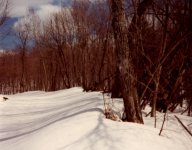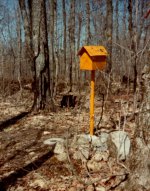Please look at the above photo. Elevation of Mt. Arvon is benchmarked at 1979', not 1976' like you seem to think, and keep trying to claim. But when you're grasping at straws, every inch counts I guess.
Seems pretty nitpicky? You bet it does. Now about the location of at least one of these claimed 2000' elevations. I guess I won't be holding my breath for that and I'm not sure I want to bother with that techno weenie crap, although I do enjoy going up and down these hills whatever the supposed actual elevation is, preferably on skis or mountain bike though.
The lithology of these one time great mountains, the result of many sequences of uplift, volcanism, folding, faulting, erosion, and sedimentation, followed by repeated glaciation, is the reason why our hills that remain as remnants of these once great mountains are limited in elevation and exist as they do today. For example, the Keweenawan rocks like the greenstone flow and conglomerates that comprise the Copper Range pretty much top out at around 1300' or so in elevation like East bluff, West bluff (aka Brockway Mt.), The cliff range, and Mt. Ojibway for example. The hills comprised of more resistant bedrock are a little higher in the 1400-1500' range like Mts. Houghton, Bohemia, Gratiot, Horace Greeley, Buffalo and Praiseville hills, Whealkate bluff, etc. Some of these hills also have till deposits on top that have added to the elevtion a little bit. The Huron mountains are even more resistant to erosion so they cap out at around 1800' to 1900' in elevation for the most part. Mt. Arvon and Mt. Curwood are examples. The hills in the Huron Mt. club are lower with Huron Mtn. around 1500' and the rest lower than that. This area was scoured as an outlet of glacial lake Agassiz to the West. The depositional area known as the Yellow Dog sand plains sits up at around 1300' for reference. The areas of sandstone and limestone have been eroded down to pretty low elevations for the most part. Limestone Mountain is one of the few remaining remnants of dolomite in the Western U.P. The hill known as Pikes Peak (near Point Abbaye) at 1100', is a quartzite outlier in an area of Jacobsville sandstone.


